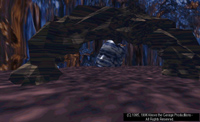
|
Unlike early development for CDROM where the biggest problem was your hard drive went too fast compared to a CD, the opposite problem occurred when planning for this new generation of hardware accelerators. There was no practical way to simulate the performance short of buying a Silicon Graphics Onyx Supercomputer with Reality Engine graphics - a several hundred thousand dollar proposition. It required a great leap of faith and imagination to believe that something clunking along at 10 fps at 400x300 resolution on your P90 was going to be running at 30 fps full-screen and high-color with a $199.00 (or less!) upgrade to your machine. But now it is happening and it is fantastic. In fact, things are getting so fast I keep increasing the art complexity (easy to do because it's all modeled with NURBS in Alias before being reduced to polygons). |
|
If you follow this link, you will see a large screen shot. This screen shot is just under 800x500 in size. I used to display a larger screen shot - 1200x800 - but it tended to break a lot of Web Browsers that couldn't handle an image that large! |
|
At the February 1998 Microsoft Meltdown, I had 12,000 triangle caverns displaying at 40 fps. That was on a P2-300 with the Real3D board (Intel i740 inside). |
|
It's difficult on a Web page to convey the experience of flying through an 800x600 scene, but, as one beta tester said, "It's like flying around in a photograph." |
|
Back to C.I.N.D.-E 1.4 |